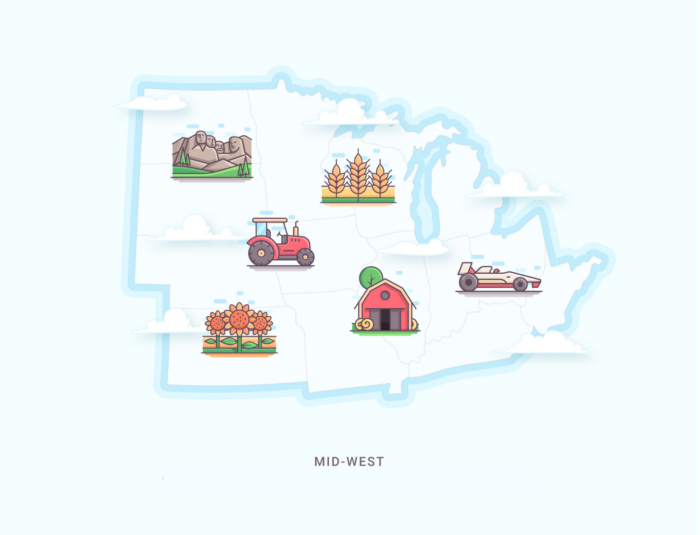In this particular edition, we’ll be looking at the Midwest region and seeing what this territory has to offer current and potential Aexus partners.
In terms of climate, the Midwest gets very cold air masses in the north and in the south it gets warm, humid air from the Gulf of Mexico. This results in a wide range of temperatures along the length of the region and is also responsible for extremes of wet and dry weather.
When you think about the American tech scene, the Midwest isn’t the first place that springs to mind but attitudes may be starting to change. Firstly, the whole country is in the middle of a tech scene revolution where traditional hubs are being replaced by hubs in smaller metropolitan areas. It’s no longer necessary to be in the Bay Area to be taken seriously. Secondly, we are in a period of rising prices where disposable income is beginning to be noticeably squeezed and the Midwest offers a solution to that. In fact, it’s home to seven of the top ten most affordable states in the nation. And lastly, with a GDP of $4.2T (2020), the Midwest alone has the fifth largest economy in the world, beating the likes of Germany, India and The United Kingdom. Now, while these statistics might be interesting in their own right, these figures all have an impact on the tech scene with new hubs meaning work is available, the lower cost of living is attracting people to the region and the strength of the economy shows there is plenty of scope for growth and investment. Actually, venture capital funding rose from $5.8 billion in 2010 to $20.2 billion in 2020. That’s more than 300%. There was a drop during the coronavirus pandemic but people were still investing unlike in the 2008 recession when everything stopped. Among the big winners in the investment rounds have been companies dealing with AI, medtech and insuretech.

The start-up scene in the Midwest has enjoyed rapid growth in the last ten years and it is only getting bigger. It is perhaps no surprise to learn that Chicago, Illinois has the lion’s share of the start-up scene but Columbus, Ohio is starting to stake its claim. Just this year, half a billion in venture capital went to two Columbus start-ups with one being healthcare technology company Olive and and the other, autonomous robotics company Path Robotics. So far in 2022, $110 million has gone into Columbus start-ups in total.
Indiana has made big strides as well and this is confirmed by the tech giants. Salesforce’s biggest presence outside of San Francisco isn’t in London, it’s in Indiana. The state also made Amazon’s shortlist for HQ2 finalists and Infosys have invested in two tech campuses in the city to extend their US presence. Indiana puts it success down to being able to offer a better quality of life, have a large pool of talent, lower operation costs, and a rich environment of innovative leaders and funders.
Milwaukee in Wisconsin is interesting because it is one of the places that is not a massive success yet but it is believed that the potential is there and it is only waiting to be tapped into. City leaders are trying to create a tech ecosystem for the area and claim that their infrastructure is second to none but that their tech advancements are hidden because they are embedded in traditional industries like insurance and manufacturing. With this in mind, it may be wise to look into what incentives the city are offering investors and entrepreneurs to come to this underutilised city.
Omaha in Nebraska is another city that’s rapidly ramping up its tech hub credentials and is considered part of the Silicone Prairie, which also includes Missouri, Indiana, Iowa, Kansas and South Dakota. Omaha is finding it easy to attract talent both in terms of start-ups and employees and in fact, the city was recently named as the best city to work in tech, according to a report by SmartAsset. On top of this, Omaha is home to large financial institutions and the innovation which has come with that has seen the city be ranked among the top five most promising fin-tech hubs in the nation.
Lastly, the “Twin Cities” of Minneapolis and Saint Paul in Minnesota should not be overlooked as they have become a buzzing hub for tech start-ups, innovation and small business. In fact, venture capitalist firm M25 named Minneapolis specifically as the second best Midwest city for start-ups. The city’s stature has really been cemented though by Bright Health’s $10 billion valuation and Boston Scientific’s $1 billion acquisition of Preventice Solutions. So, while Minneapolis remains at the top of medtech for now, there are other cities vying to take its crown. In its favour though is that medical innovation is a bit of a tradition here but funding will probably be the deciding factor in whether or not it remains in pole position.
Conclusion
There is still a long way to go in our series on where would be best to scale to in the US but there are a lot of positives to take from this edition on the Midwest. You may have already had ideas about where you think your particular domain is best suited but with 3 more regions still to look at, you may find something better in a later post. Until then, please feel free to leave your comments below and if you’d like to work with us directly to find your perfect route into the US, get in touch. We’re always more than happy to jump on a call.
